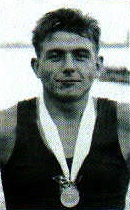Background
This was the ninth appearance of the event. Rowing had been on the programme in 1896 but was cancelled due to bad weather. The coxed four was one of the four initial events introduced in 1900. It was not held in 1904 or 1908, but was held at every Games from 1912 to 1992 when it (along with the men's coxed pair) was replaced with the men's lightweight double sculls and men's lightweight coxless four. [2]
The Italian team was regarded as the slight favourite for the event; they had won gold at the European Rowing Championships in 1949, silver in 1950, and gold again in 1951, with the team having changed between competitions. Of the New Zealand team that had won the 1950 British Empire Games, three rowers were in the 1952 Olympic event: Ted Johnson, John O'Brien, and Colin Johnstone. The Danish team was made up of the 1950 European Rowing Championships winners: Niels Kristensen, Ove Nielsen, Peter Hansen, Bent Blach Petersen, and Eivin Kristensen. The New Zealand and Italian team met in the repechage and New Zealand was eliminated. The Czechoslovak team dominated the competition and won every round. In the final, they defeated the Swizz quad, while the team from the USA—the winners of the 1948 Olympic competition—won bronze. [1]
Egypt and the Soviet Union each made their debut in the event. France and the United States both made their seventh appearance, tied for most among nations to that point.
The coxed four event featured five-person boats, with four rowers and a coxswain. It was a sweep rowing event, with the rowers each having one oar (and thus each rowing on one side). The competition used the 2000 metres distance that became standard at the 1912 Olympics and which has been used ever since except at the 1948 Games. [3]
Based on a previous decision, each boat raced a minimum of two races before it could be eliminated.
The competition featured five rounds (three main rounds and two repechages).
- Quarterfinals: 4 heats, 4 or 5 boats each, top 2 in each heat (8 total) advanced to the semifinals while others (9 boats) went to the first repechage.
- First repechage: 3 heats, 3 boats each, top 1 in each heat (3 total) advanced to the second repechage (not the semifinals) while all others (6 boats) were eliminated.
- Semifinals: 2 heats, 4 boats each, top 1 in each heat (2 total) advanced to the final while all others (6 boats) went to the second repechage.
- Second repechage: 3 heats, 3 boats each, to 1 in each heat (3 total) advanced to the final while all others (6 boats) were eliminated.
- Final: 1 heat, 5 boats, determining medals and 4th and 5th places.
This page is based on this
Wikipedia article Text is available under the
CC BY-SA 4.0 license; additional terms may apply.
Images, videos and audio are available under their respective licenses.


